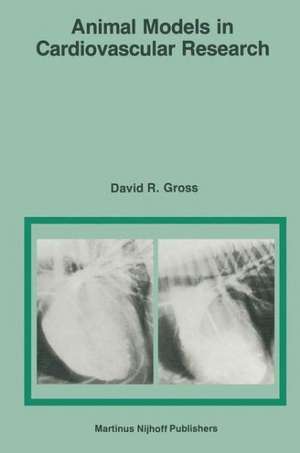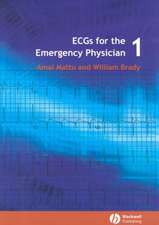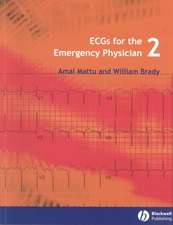Animal Models in Cardiovascular Research
Autor D.R. Grossen Limba Engleză Paperback – 5 oct 2011
Preț: 734.17 lei
Preț vechi: 772.81 lei
-5% Nou
Puncte Express: 1101
Preț estimativ în valută:
140.49€ • 150.23$ • 117.13£
140.49€ • 150.23$ • 117.13£
Carte tipărită la comandă
Livrare economică 17 aprilie-01 mai
Preluare comenzi: 021 569.72.76
Specificații
ISBN-13: 9789401087179
ISBN-10: 9401087172
Pagini: 636
Ilustrații: 630 p.
Dimensiuni: 155 x 235 x 33 mm
Greutate: 0.88 kg
Ediția:Softcover reprint of the original 1st ed. 1985
Editura: SPRINGER NETHERLANDS
Colecția Springer
Locul publicării:Dordrecht, Netherlands
ISBN-10: 9401087172
Pagini: 636
Ilustrații: 630 p.
Dimensiuni: 155 x 235 x 33 mm
Greutate: 0.88 kg
Ediția:Softcover reprint of the original 1st ed. 1985
Editura: SPRINGER NETHERLANDS
Colecția Springer
Locul publicării:Dordrecht, Netherlands
Public țintă
ResearchCuprins
1: General Principles of Animal Selection, Pre- and Post-Operative Care, Preanesthesia, Chemical Restraint and Analgesia.- 1. Physical examination.- 2. Normal physiological parameters.- 3. Animal behavior considerations.- 4. Special requirement considerations.- 5. The use of anticholinergic drugs for preanesthesia.- 6. Preanesthetic agents.- 7. Recognition of pain and the use of analgesics.- 2: Cardiovascular Effects of the Opiods.- 1. Morphine.- 2. Meperidine.- 3. Methadone.- 4. Pentazocine.- 5. Fentanyl.- 6. Oxymorphone.- 7. Naloxone.- 8. Etorphine.- 9. Others.- 3: Cardiovascular Effects of the Tranquilizers.- 1. Phenothiazine derivatives.- 2. Butyrophenones.- 3. Benzodiazephines.- 4. Rauwolfia derivatives.- 5. Xylazine.- 4: Cardiovascular Effects of Other Drugs Commonly Used in Cardiovascular Research.- 1. Combinations.- 2. Neuromuscular blocking agents.- 3. Skeletal muscle relaxants.- 4. Non-steroidal anti-inflammatory and analgesic agents.- 5. Antibiotics.- to the Anesthetic Agents.- 5: Cardiovascular Effects of Intravenous Anesthetic Agents.- 1. Barbiturates.- 2. Alpha-chloralose.- 3. Urethane.- 4. Alpha-chloralose and urethane combined.- 6: Cardiovascular Effects of Inhalant Anesthetic Agents.- 1. Halothane.- 2. Enflurane.- 3. Methoxyflurane and Isoflurane.- 4. Diethyl ether.- 5. Nitrous oxide.- 6. Cyclopropane, Chloroform, Fluroxene and Trichlorethylene.- 7: Cardiovascular Effects of Halucinogens, Neurolept Analgesic/Anesthetic Combinations and Steroid Anesthetics.- 1. Ketamine.- 2. Ketamine-tranquilizer combinations.- 3. Tranquilizer — opiod combinations.- 4. Guaifenesin and the steroid anesthetics.- 8: Effects of Chemical Restraint and Anesthesia on Blood Glucose Levels.- 1. Opiods.- 2. Tranquilizers.- 3. Xylazine.- 4. Barbiturates.- 5. Urethane.- 6.Inhalent anesthesia.- 7. Neurolept analgesics/anesthetics.- 8. Droperidol and Fentanyl.- 9: Normal Cardiovascular Parameters from Intact, Awake Animals.- 1. Dogs.- 2. Cats.- 3. Rats.- 4. Rabbits.- 5. Sheep.- 6. Calves.- 7. Pigs.- 8. Ponies.- 9. Primates.- 10: Naturally Occurring Models of Cardiovascular Disease.- 11: Iatrogenic Models for Studying Heart Disease.- 1. Heart failure models.- 2. Portal hypertension models.- 3. Isolated heart preparations.- 4. Microvascular studies.- 5. Organ culture.- 6. Streptococcal rheumatic carditis.- 12: Animal Models of Atherosclerosis.- 1. Quantification techniques.- 2. Pathogenesis.- 3. Natural occurrence.- 4. Specific animal models.- 5. Regression studies.- 13: Animal Models of Hypertension.- 1. Renovascular hypertension.- 2. Spontaneously hypertensive rats (SHR).- 3. Dahl salt-sensitive rats.- 4. Salt and DOCA — salt models.- 5. Neurogenic hypertension and the central component.- 14: In-Vivo Measurements, Pitfalls and Problems of Instrumentation.- 1. Transduction of physiological events.- 2. Recording.- 3. Measuring electrical events.- 4. Measuring force and pressure events.- 5. Measuring interstitial fluid pressures.- 6. Measuring pressure in the micro-vasculature.- 7. Indirect techniques for measuring arterial pressures.- 8. Measuring flow events.- 9. Measuring chemical events.- 10. Measuring dimension changes.- 11. Measuring temperature changes.- 12. Calculation and/or measurement of volumes.- 13. Use of the microsphere technique for estimating tissue blood flows.













